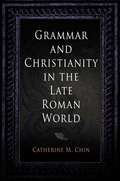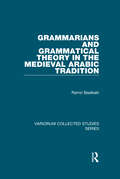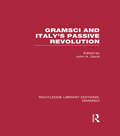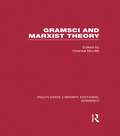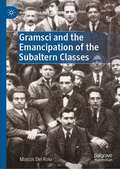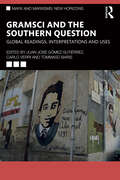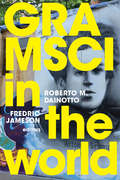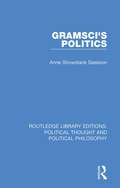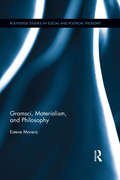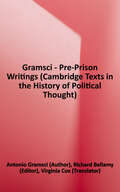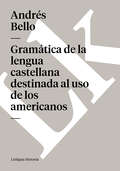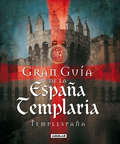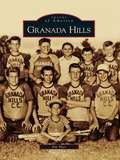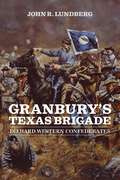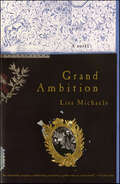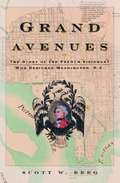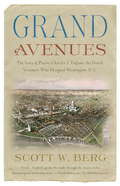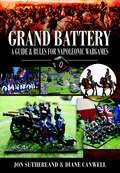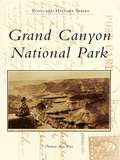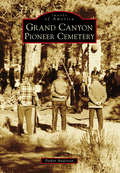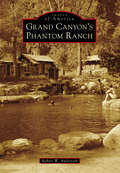- Table View
- List View
Grammar and Christianity in the Late Roman World
by Catherine M. ChinBetween the years 350 and 500 a large body of Latin artes grammaticae emerged, educational texts outlining the study of Latin grammar and attempting a systematic discussion of correct Latin usage. These texts--the most complete of which are attributed to Donatus, Charisius, Servius, Diomedes, Pompeius, and Priscian--have long been studied as documents in the history of linguistic theory and literary scholarship. In Grammar and Christianity in the Late Roman World, Catherine Chin instead finds within them an opportunity to probe the connections between religious ideology and literary culture in the later Roman Empire.To Chin, the production and use of these texts played a decisive role both in the construction of a pre-Christian classical culture and in the construction of Christianity as a religious entity bound to a religious text. In exploring themes of utopian writing, pedagogical violence, and the narration of the self, the book describes the multiple ways literary education contributed to the idea that the Roman Empire and its inhabitants were capable of converting from one culture to another, from classical to Christian. The study thus reexamines the tensions between these two idealized cultures in antiquity by suggesting that, on a literary level, they were produced simultaneously through reading and writing techniques that were common across the empire.In bringing together and reevaluating fundamental topics from the fields of religious studies, classics, education, and literary criticism, Grammar and Christianity in the Late Roman World offers readers from these disciplines the opportunity to reconsider the basic conditions under which religions and cultures interact.
Grammarians and Grammatical Theory in the Medieval Arabic Tradition (Variorum Collected Studies #782)
by Ramzi BaalbakiProfessor Baalbaki deals here with the Arabic grammatical tradition and the analytical methods of the medieval Arab grammarians. The essays included open new perspectives on the most authoritative work on Arabic grammar, Sibawayhi's tome or Kitab, on the relation between grammatical study and other areas of linguistic enquiry such as Qur'anic readings and stylistics, and on the techniques which the grammarians employed to explain and rationalize usage and to incorporate within their system the vast body of dialectal material which the corpus comprises. The author has sought to highlight the central position which Arabic grammar enjoys within the wider Arab culture, and in so doing has examined several aspects of a legacy which has been revered over a millennium and which forms to this very day the backbone of the teaching of grammar in the Arab world.
Gramsci (RLE (RLE (RLE (RLE (RLE (RLE (RLE (RLE: Gramsci): And Italy's Passive Revolution
by John A. DavisAntonio Gramsci used the term ‘passive revolution’ to describe the limitations and weaknesses of the 19th century bourgeois state in Italy which permitted economic development whilst thwarting social and political progress. This detailed study consists of seven essays each exploring a different theme of the economic and social basis of the Liberal state, providing a broad understanding of the background against the emergence of Italian fascism and present a number of debates and controversies amongst Italian historians. By critical discussion of Gramsci’s reading of modern Italian history, the essays present an analysis of the structure and development of social and economic relations in the formation of the Liberal state, illustrating the transition from liberalism to fascism.
Gramsci and Marxist Theory (RLE: Gramsci)
by Chantal MouffeThis book familiarizes the English-speaking reader with the debate on the originality of Gramsci’s thought and its importance for the development of Marxist theory. The contributors present the principal viewpoints regarding Gramsci’s theoretical contribution to Marxism, focussing in particular on his advances in the study of the superstructures, and discussing his relation to Marx and Lenin and his influence in Eurocommunism. Different interpretations are put forward concerning the elucidation of Gramsci’s key concepts, namely: hegemony, integral state, war of position and passive revolution.
Gramsci and Trotsky in the Shadow of Stalinism: The Political Theory and Practice of Opposition
by Emanuele SaccarelliThis book examines the legacy of Antonio Gramsci and Leon Trotsky in the shadow of Stalinism in order to reassess the very different and distorted academic reception of the two figures, as well as to contribute to the revitalization of Marxism for our time. While Gramsci and Trotsky lived and died in a similar fashion, as revolutionary Marxist leaders and theoreticians, their reception in academia could not be more different. Gramsci has become tremendously popular, becoming a central figure in many disciplines, while Trotsky remains largely ignored. Saccarelli argues that not only is Gramsci popular for the wrong reasons--being routinely distorted and depoliticized--even when rescued from his contemporary users, Gramsci remains inadequate. Conversely, the fact that Trotsky remains beyond the pale of "theory" is a terrible indictment of the current state of academic thinking.
Gramsci and the Emancipation of the Subaltern Classes (Marx, Engels, and Marxisms)
by Marcos Del RoioThis book outlines essential issues of Antonio Gramsci’s thought, from his relationship to other political thinkers, including Rosa Luxemburg, Lenin, and Machiavelli; the development of his key conceptual categories; and the applicability of those categories in contemporary contexts. The author demonstrates how Gramsci’s revolutionary strategy begins with the knowledge of the subaltern classes’ common sense, and their elements of rebellion, in order to establish a dialectical relationship between intellectuals and the masses. That relationship promotes collective intellectual progress, ultimately leading to an effective philosophy of praxis, founded on labor and a new hegemony. The book demonstrates that Gramsci’s thought offers possibilities for understanding the serious crises of today.
Gramsci and the Southern Question: Global Readings, Interpretations and Uses (Marx and Marxisms)
by Juan José Gómez Gutiérrez, Carlo Verri and Tommaso BarisThis book looks at the Southern question in Antonio Gramsci. It takes this as an opportunity to reflect on the special nature of his thought, linked to the concepts of hegemony, subalternity and the critique of the particular culturalidentitarian and ideological forms of the South and its historical development.Although the category was originally applied to the politics and history of Italy, the debates on the Southern question have in recent times gained wider relevance, combining with today’s more general analyses relating, for example, to European geopolitics, globalisation and the various global Souths, to media and mass culture, etc. In other areas, the Southern question in Gramsci has taken the form of a materialist epistemology, connected to the historical phenomenon of the splitting of consciousness, as opposed to its unity on a theoretical level. Elsewhere, it has become a programme for the application of a strategy of the international left, based on the building of alliances between different groups of subalterns. Over time, Gramsci's thought has come into contact with other partly converging perspectives, such as critical urban theory and cultural and subaltern studies.This has given rise to numerous fruitful lines of research in which the Southern question has been extended from Italy’s own North-South divide to other contexts. What aspect of Gramsci’s thought could justify this issue taking on such importance? Gramsci and the Southern Question: Global Readings, Interpretations and Uses aims to answer this question by combining general theoretical approaches with studies on the reception of Gramscian concepts in the world’s Souths.
Gramsci in the World
by Roberto Dainotto and Fredric JamesonAntonio Gramsci's Prison Notebooks have offered concepts, categories, and political solutions that have been applied in a variety of social and political contexts, from postwar Italy to the insurgencies of the Arab Spring. The contributors to Gramsci in the World examine the diverse receptions and uses of Gramscian thought, highlighting its possibilities and limits for understanding and changing the world. Among other topics, they explore Gramsci's importance to Caribbean anticolonial thinkers like Stuart Hall, his presence in decolonial indigenous movements in the Andes, and his relevance to understanding the Chinese Left. The contributors consider why Gramsci has had relatively little impact in the United States while also showing how he was a major force in pushing Marxism beyond Europe—especially into the Arab world and other regions of the Global South. Rather than taking one interpretive position on Gramsci, the contributors demonstrate the ongoing relevance of his ideas to revolutionary theory and praxis.Contributors. Alberto Burgio, Cesare Casarino, Maria Elisa Cevasco, Kate Crehan, Roberto M. Dainotto, Michael Denning, Harry Harootunian, Fredric Jameson, R. A. Judy, Patrizia Manduchi, Andrea Scapolo, Peter D. Thomas, Catherine Walsh, Pu Wang, Cosimo Zene
Gramsci's Politics (Routledge Library Editions: Political Thought and Political Philosophy #51)
by Anne Showstack SassoonFirst published in 1980. This book analyses Gramsci’s political theory and the consequences of his ideas for the theory of the state and of the political party. Using the new tools of analysis which have been developed in Italy the book presents Gramsci’s political theory as part of the attempt to develop further a Marxist theory of politics. The book also serves as a basis for considering the theoretical foundations of political developments such as Eurocommunism and the author argues that Gramsci’s political thought provides useful instruments for both a critique of Stalinism and of social democracy and offers a grounding for conceptualising democratic forms of socialism which did not simply reinforce the State. This title will be of interest to students of politics, philosophy, and history.
Gramsci, Materialism, and Philosophy (Routledge Studies in Social and Political Thought)
by Esteve MoreraWestern critical theory, Marxism included, has largely been based on a view of historical materialism that Gramsci, among others, developed in his prison notebooks. For many, Gramsci’s philosophical reflections in prison offered a new foundation for the philosophy of the future. His reflections on the philosophy of praxis and absolute historicism find echoes in much of what today is considered to be a materialist philosophy. That form of materialism was unable to provide a sound foundation for a progressive social project, the possibility of a meaningful and creative ethical life, and the forms of activity or praxis that would be conducive to creating good society. In this book, Esteve Morera connects Marxist philosophy to the broader philosophical discussion of materialism in metaphysics, the philosophy science, philosophy of mind, and naturalised ethics. Each chapter deals with a particular aspect related to materialism and its consequences, the sorts of things that, if materialism is true, need to be confronted. Morera critiques, and rejects Gramsci’s conception of matter and materialism and concludes that that philosophical materialism is compatible with freedom, and as a consequence, offers a good foundation for ethical life. Gramsci, Materialism, and Philosophy is an original contribution to the philosophically vital debates around the meaning, limitations, implications, and possibilities of philosophical materialism as it is a contribution to the critical literature on Gramsci.
Gramsci: Pre-Prison Writings (Cambridge Texts in the History of Political Thought)
by Antonio GramsciThis collection of Gramsci's pre-prison writings, newly translated and including several pieces not previously available in English, encompasses the full range of his journalistic activity, from general cultural criticism to commentaries on local, national, and international events. It will be of interest to a broad range of scholars and students concerned with the history of political, social, and cultural thought in the twentieth century.
Gramática de la lengua castellana destinada al uso de los americanos
by Andrés BelloThe grammar of Andrés Bello laid the laws of Castilian Language in America and was an element of identity which, in the 19th century, represented the breadth of the language spoken throughout both the Iberian Peninsula and the West.
Gran Guía de la España Templaria
by TemplespañaLa Guía más completa de la España Templaria que conocemos hasta el momento. Tras la primera Cruzada las ruinas del templo de Salomón se convirtieron en escenario del nacimiento de una nueva Orden de monjes-guerreros: los templarios. La misión de estos soldados de Cristo era la de preservar a los cristianos y los Santos Lugares de la amenaza de los infieles. A medida que su fama y su influencia se extendían por Oriente y Occidente aumentaban las leyendas y los misterios asociados a la Orden del Temple. En España su presencia es importante y su historia, rica en acontecimientos destacados. Participaron en la Reconquista y construyeron asentamientos en los reinos cristianos de Aragón, Castilla, Navarra y León, donde crearon sus propias iglesias, oratorios y camposantos; un magnífico patrimonio de carácter eclesiástico y pecuniario ubicado en territorios destacados por su significado místico. Gran guía de la España Templaria nos propone un sugerente recorrido por los enclaves templarios más destacados de la Península, un itinerario plagado de asombrosos enigmas e historias trepidantes que ponen de manifiesto el carácter contemplativo y combatiente de la orden religiosa más cautivadora de todos los tiempos.
Gran Obra de Todos los Tiempos
by Alondra Silva Muñoz Felipe Gomes BiavoUna pequeña huérfana china necesita probar que es digna de ser la primera mujer en el Círculo de los Alquimistas, incluso si para eso necesita revelar un secreto. En este pequeño cuento que ocurre en la recién unificada China de la dinastía Qin, Liang, una huérfana de 15 años, es adoptada por un maestro alquimista y se vuelve su aprendiz. Liang descubre que los siete alquimistas del reino fueron convocados por el emperador Qin Shihuang para crear un legendario elixir y ve ahí su oportunidad de probar que ser mujer no le impedirá volverse una gran alquimista. Para eso, contará con su gran secreto (y, ahora, su gran triunfo): ella nació con magia.
Granada Hills
by Jim HierThe modern history of Granada Hills began in 1913 with the completion of the Los Angeles aqueduct and the arrival of abundant freshwater to the former land of Mission San Fernando. Citrus orchardsflourished on the Sunshine Ranch, acreage originally cultivated by former senator George K. Porter. In 1926, the community of Granada was formed as a rabbit-raising colony, promising residents country living and economic prosperity. Granada added "Hills" to its name in 1942 to avoid confusion with a similarly named Northern California town, andthanks to the postwar baby boom, the population grew by 1,000 percent between 1950 and 1960. The community soon earned a reputation as "The San Fernando Valley's Most Neighborly Town" as residents came together to celebrate the hometown team's 1963 Little League World Series victory and the formation of the nation's first all-girl American Youth Soccer Organization league, and as neighbor helped neighborafter the devastating 1971 and 1994 earthquakes.
Granbury's Texas Brigade: Diehard Western Confederates (Conflicting Worlds: New Dimensions of the American Civil War)
by John R. LundbergJohn R. Lundberg's compelling new military history chronicles the evolution of Granbury's Texas Brigade, perhaps the most distinguished combat unit in the Confederate Army of Tennessee. Named for its commanding officer, Brigadier General Hiram B. Granbury, the brigade fought tenaciously in the western theater even after Confederate defeat seemed certain. Granbury's Texas Brigade explores the motivations behind the unit's decision to continue to fight, even as it faced demoralizing defeats and Confederate collapse. Using a vast array of letters, diaries, and regimental documents, Lundberg offers provocative insight into the minds of the unit's men and commanders. The caliber of that leadership, he concludes, led to the group's overall high morale.Lundberg asserts that although mass desertion rocked Granbury's Brigade early in the war, that desertion did not necessarily indicate a lack of commitment to the Confederacy but merely a desire to fight the enemy closer to home. Those who remained in the ranks became the core of Granbury's Brigade and fought until the final surrender. Morale declined only after Union bullets cut down much of the unit's officer corps at the Battle of Franklin in 1864.After the war, Lundberg shows, men from the unit did not abandon the ideals of the Confederacy -- they simply continued their devotion in different ways. Granbury's Texas Brigade presents military history at its best, revealing a microcosm of the Confederate war effort and aiding our understanding of the reasons men felt compelled to fight in America's greatest tragedy.
Grand Ambition: A Novel
by Lisa Michaels"An absorbing, affecting and beautifully written novel."—New York Times Book Review In Lisa Michaels's enthralling debut novel, she weaves the tale of two young newlyweds, Glen and Bessie Hyde, who set out in 1928 to run the rapids of the Grand Canyon. The pair hoped to set a record: Bessie would be the first woman to negotiate that treacherous stretch of the Colorado River. When they failed to appear at their destination on time, Glen's father mounted a desperate search to find them. Based on the few known facts of a true story, Grand Ambition contemplates our need for risk and danger, and treats with great complexity the power of youthful passion. Reading Group Guide included.
Grand Army of Labor: Workers, Veterans, and the Meaning of the Civil War (Working Class in American History #1)
by Matthew E. StanleyEnlisting memory in a new fight for freedom From the Gilded Age through the Progressive era, labor movements reinterpreted Abraham Lincoln as a liberator of working people while workers equated activism with their own service fighting for freedom during the war. Matthew E. Stanley explores the wide-ranging meanings and diverse imagery used by Civil War veterans within the sprawling radical politics of the time. As he shows, a rich world of rituals, songs, speeches, and newspapers emerged among the many strains of working class cultural politics within the labor movement. Yet tensions arose even among allies. Some people rooted Civil War commemoration in nationalism and reform, and in time, these conservative currents marginalized radical workers who tied their remembering to revolution, internationalism, and socialism. An original consideration of meaning and memory, Grand Army of Labor reveals the complex ways workers drew on themes of emancipation and equality in the long battle for workers’ rights.
Grand Avenue
by Greg SarrisShort stories that portray yearning teenagers, jilted lovers, struggling parents, and elderly healers among poor Pomo Indians, Mexicans, Blacks and Portuguese.
Grand Avenue:The Story of the French Visionary Who Designed Washington DC
by Scott W. BergGrand Avenues tells the riveting story of Pierre Charles L'Enfant and the creation of Washington, D.C. from the seeds of his inspiration to the fulfillment of his extraordinary vision. L'Enfant's story is one of consuming passion, high emotion, artistic genius, and human frailty. As a boy he studied drawing at the most prestigious art academy in the world. As a young man he left his home in Paris to volunteer in the army of the American colonies, where he served under George Washington. There he would also meet many of the people who would have a profound impact on his life, including Alexander Hamilton and James Monroe. And it was Washington himself who, in 1791, entrusted L'Enfant with the planning of the nation's capital and reluctantly allowed him to be dismissed from the project eleven months later. The plan for the city was published under another name, and for the remainder of his life L'Enfant fought for recognition of his achievement. But he would not live to see that day, and a century would pass before L'Enfant would be given credit for his brilliant design. Scott W. Berg recounts this tale, richly evocative of time and place, with the narrative verve of a novel and a cast of characters that ranges from Thomas Jefferson and the other Founding Fathers to the surveyor who took credit for L'Enfant's plans, the assistant who spent a week in jail for his loyalty to L'Enfant, and the men who finally restored L'Enfant's reputation at the beginning of the twentieth century. Here is a fascinating, little-explored episode in American history: the story of a visionary artist and of the founding of the magnificent city that is his enduring legacy.
Grand Avenues: The Story of Pierre Charles l'Enfant, the French Visionary Who Designed Washington, D.C.
by Scott W. BergIn 1791, shortly after the United States won its independence, George Washington personally asked Pierre Charles l'Enfant--a young French artisan turned American revolutionary soldier who gained many friends among the Founding Fathers--to design the new nation's capital. L'Enfant approached this task with unparalleled vigor and passion; however, his imperious and unyielding nature also made him many powerful enemies. After eleven months, Washington reluctantly dismissed l'Enfant from the project. Subsequently, the plan for the city was published under another name, and l'Enfant died long before it was rightfully attributed to him. Filled with incredible characters and passionate human drama, Scott W. Berg's deft narrative account of this little-explored story in American history is a tribute to the genius of Pierre Charles l'Enfant and the enduring city that is his legacy.
Grand Battery: A Guide & Rules for Napoleonic Wargames
by Diane Canwell Jon SutherlandHow would you have fared as one Napoleon's marshals, or in command of a division of redoutable British redcoats under Wellington? Grand Battery offers you the chance to find out. This book includes all the rules you need to play miniature wargames set in the Napoleonic Wars, plus plenty of useful background information you need to get started.The book provides a concise historical overview of the events and battles of the period, and includes sections on the weapons and tactics of the various armies. The buyer's guide gives an up-to-date survey of the wealth of ranges of miniatures available and advice on which are compatible with which. Organizational tables give a breakdown of typical formations for all the major combatants and most of the minor ones (any one for a Wurttemburg infantry division?), allowing you to structure your collection and also to organize hypothetical games quickly with 'off the peg' orders of battle. Three historical scenarios are also included, each with their own specific orders of battle, maps, objectives and victory conditions.The rules themselves, which utilize an innovative card-driven turn sequence to simulate the unpredictable ebb and flow of battle, are designed for playability, while still giving 'realistic' results and rewarding sound tactics. Though designed primarily for division level games with 25 or 15mm figures, the command and control system takes account of corps or even the largest army level games and they are easily adaptable to any figure scale. Get ready to march to the sound of the guns!
Grand Canyon National Park
by Thomas Alan RatzArizona is proud to have one of the Seven Natural Wonders of the World--the Grand Canyon. With the arrival of the Santa Fe and Union Pacific Railroad in the early 20th century, the development of the canyon began in earnest. The railroads, along with the Santa Fe's business partner, the Fred Harvey Company, greatly promoted the Grand Canyon as a tourist destination through books, pamphlets, and magazine advertisements. On February 26, 1919, Congress established the Grand Canyon National Park, and the federal government became a promoter of the Grand Canyon, too. But perhaps the best promoters of the Grand Canyon were the people who wrote home on picture postcards telling their friends and families about the amazing canyon. A number of the postcards published about the park can be found within the pages of this book.
Grand Canyon Pioneer Cemetery
by Parker AndersonOne of the most historically significant places at the Grand Canyon, yet one of the least known, is the Grand Canyon Pioneer Cemetery. Very few national parks have an active burial ground, but the pioneers who rest here represent all walks of life throughout the canyon's history. Pioneer Cemetery is the final resting place for miners, businessmen, park superintendents, rangers, mule wranglers, and even some local characters. Legendary residents of the Grand Canyon, including John Hance, Pete Berry, Ralph Cameron, William Wallace Bass, and the Kolb brothers are also buried onsite, secluded in a beautiful grove of pine trees. It is an area of the Grand Canyon that is seldom written about or discussed.
Grand Canyon's Phantom Ranch
by Robert W. AudretschPhantom Ranch is nestled in the Grand Canyon basin on the Colorado River--a location hardly visible from the rim and only accessible after a journey through scores of geologic layers. The only way there is by river rafting, hiking, or mule, and with each foot of the journey, the traveler descends 30,000 years in geologic time. While at Phantom Ranch, the view looking above is of 1.7 billion years of geology, all swirling together in an alphabet of colors. Grand Canyon's Phantom Ranch is the story of the rustic buildings designed by architect Mary Jane Colter in 1921, of the park's first peoples, river rafters, the early trail and bridge builders, and dramatic flash floods. When travelers leave Phantom Ranch, they are never the same. For some of them, departing is as if they have just said good-bye to an old friend.
